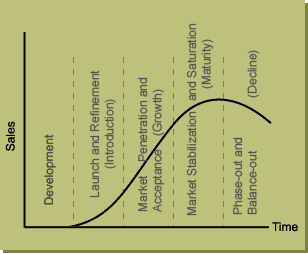Home | EXCEL VBA (XL97-2003) | EXCEL VB.Net | ACCESS VBA | EXCEL Spreadsheet Functions | Material Management | About me
The Product Life Cycle
The duration of product's life cycle may be as short as a few months for a fad item or many years for some product categories.
After a period of design and development the product is introduced or launched into the market; it gains more and more customers as it grows; eventually the market stabilizes and the product becomes mature; then after a period of time the product is overtaken by development and the introduction of superior competitors, it goes into decline and is eventually withdrawn. However, most products fail in the introduction phase. Others have very cyclical maturity phases where declines see the product promoted to regain customers.

Strategies for the differing stages of the Product Life Cycle.
Introduction stage.
The product is promoted to create awareness and its benefits. The higher costs coupled with low sales volume usually make the introduction stage a period of negative profits. The primary goal is to establish a market and build primary demand for the product. If the product has no or few competitors, a skimming price strategy is employed. Limited numbers of product are available in few channels of distribution.
Growth stage.
Competitors are attracted into the market with very similar offerings. Products at this stage enjoy rapid revenue growth, and companies form alliances and joint ventures. Advertising spend is high and focuses upon building brand. Market share tends to stabilize.
Maturity stage.
During maturity stage, the primary goal is to maintain market share and extend the product life cycle. Products that survive the earlier stages tend to spend longest in this phase. Sales grow at a decreasing rate and then stabilize. Producers attempt to differentiate products and brands are key to this. Price wars and intense competition occur. At this point the market reaches saturation. Producers begin to leave the market due to poor margins. Promotion becomes more widespread and use a greater variety of media.
Decline stage.
At this stage there is a downturn in the market. Sales declines as market becomes saturated, the product becomes technologically obsolete, more innovative products are introduced or consumer tastes have changed. There is intense price-cutting and many more products are withdrawn from the market. Profits can be improved by reducing marketing spend and cost cutting.
Problems with Product Life Cycle.
In reality very few products follow such a prescriptive cycle. The length of each stage varies enormously. The decisions of marketers can change the stage, for example from maturity to decline by price-cutting. Not all products go through each stage. Some go from introduction to decline. It is not easy to tell which stage the product is in.